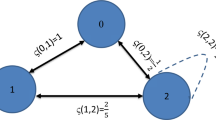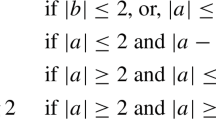Abstract
We study several embeddings of doubling metrics into low dimensional normed spaces, in particular into ℓ 2 and ℓ ∞ . Doubling metrics are a robust class of metric spaces that have low intrinsic dimension, and often occur in applications. Understanding the dimension required for a concise representation of such metrics is a fundamental open problem in the area of metric embedding. Here we show that the n-vertex Laakso graph can be embedded into constant dimensional ℓ 2 with the best possible distortion, which has implications for possible approaches to the above problem.
Since arbitrary doubling metrics require high distortion for embedding into ℓ 2 and even into ℓ 1, we turn to the ℓ ∞ space that enables us to obtain arbitrarily small distortion. We show embeddings of doubling metrics and their ”snowflakes” into low dimensional ℓ ∞ space that simplify and extend previous results.

Similar content being viewed by others
Notes
It is quite conceivable that 2 dimensions suffice, we used 3 to simplify the analysis.
Note that all the angles are less than π/8, 𝜃 w ,𝜃 x ≤1, so the higher terms of the Taylor expansion are indeed negligible.
References
Abraham, I., Bartal, Y., Neiman, O.: Embedding metric spaces in their intrinsic dimension. In: Proceedings of the 19th Annual ACM-SIAM Symposium on Discrete Algorithms, SODA ’08, pp. 363–372. Society for Industrial and Applied Mathematics, Philadelphia (2008)
Assouad, P.: Plongements lipschitziens dans ℝn. Bull. Soc. Math. France 111(4), 429–448 (1983)
Bo, B., Charikar, M.: On the impossibility of dimension reduction in l1. J. ACM 52(5), 766–788 (2005)
Bartal, Y., Gottlieb, L.-A., Krauthgamer, R.: The traveling salesman problem: low-dimensionality implies a polynomial time approximation scheme. In: Proceedings of the 44th symposium on Theory of Computing, STOC ’12, pp 663–672. ACM, New York (2012)
Bollobás, B.: Extremal graph theory. Academic Press Inc. [Harcourt Brace Jovanovich Publishers], London (1978)
Bartal, Y., Recht, B., Schulman, L.J.: Dimensionality reduction: beyond the johnson-lindenstrauss bound. In: Proceedings of the 22nd Annual ACM-SIAM Symposium on Discrete Algorithms, SODA ’11, pp. 868–887. SIAM (2011)
Hubert Chan, T-H., Gupta, A., Maggs, B.M., Zhou, S.: On hierarchical routing in doubling metrics. In: Proceedings 16th Annual ACM-SIAM Symposium on Discrete Algorithms (SODA) (2005)
Hubert Chan, T.-H., Gupta, A., Talwar, K.: Ultra-low-dimensional embeddings for doubling metrics. J. ACM 57(4) (2010)
Cheeger, J., Kleiner, B.: Differentiating maps into L 1, and the geometry of BV functions. Annals of Math. 171(2), 1347–1385 (2010)
Cheeger, J., Kleiner, B., Assaf Naor, A.: (logn)Ω(1) integrality gap for the sparsest cut sdp. In: Proceedings of the 2009 50th Annual IEEE Symposium on Foundations of Computer Science, FOCS ’09, pp 555–564. IEEE Computer Society, Washington (2009)
Gottlieb, L.-A., Krauthgamer, R.: A nonlinear approach to dimension reduction. In: Proceedings of the 22nd Annual ACM-SIAM Symposium on Discrete Algorithms, SODA ’11, pp. 888–899. SIAM (2011)
Gupta, A., Krauthgamer, R., Lee, J.R.: Bounded geometries, fractals, and lowdistortion embeddings. In: Proceedings of the 44th Annual IEEE Symposium on Foundations of Computer Science, FOCS 03, pp. 534–543. IEEE Computer Society,Washington, DC (2003)
Gottlieb, L.-A., Roditty, L.: Improved algorithms for fully dynamic geometric spanners and geometric routing. In: Proceedings of the 19th Annual ACM-SIAM Symposium on Discrete Algorithms, SODA 08, pp. 591–600. Society for Industrial and Applied Mathematics, Philadelphia (2008)
Har-Peled, S., Mendel, M.: Fast construction of nets in low-dimensional metrics and their applications. SIAM J. Comput. 35(5), 1148–1184 (2006)
Jaffe, A., Lee, J.R., Moharrami, M.: On the optimality of gluing over scales. In: Proceedings of the 12th International Workshop and 13th International Workshop on Approximation, Randomization, and Combinatorial Optimization. Algorithms and Techniques, APPROX ’09 / RANDOM ’09, pp. 190–201,Berlin, Springer-Verlag, Heidelberg (2009)
Krauthgamer, R., Lee, J.R., Mendel, M., Naor, A.: Measured descent: a new embedding method for finite metrics. Geom. Funct. Anal. 15(4), 839–858 (2005)
Laakso, T.J.: Plane with A ∞ -weighted metric not bi-Lipschitz embeddable to ℝN. Bull. London Math. Soc. 34(6), 667–676 (2002)
Linial, N., London, E., Rabinovich, Y.: The geometry of graphs and some of its algorithmic applications. Combinatorica 15(2), 215–245 (1995)
Lee, J.R., Mendel, M., Naor, A.: Metric structures in l1: dimension, snowflakes, and average distortion. Eur. J. Comb. 26(8), 1180–1190 (2005)
Lee, J.R., Naor, A.: Embedding the diamond graph in l p and dimension reduction in l 1, 745–747 (2004)
Lang, U., Plaut, C.: Bilipschitz embeddings of metric spaces into space form. Geometriae Dedicata 87(1–3), 285–307 (2001)
Lee, J.R.: Anastasios Sidiropoulos. Near-optimal distortion bounds for embedding doubling spaces into l1. In: Proceedings of the 43rd Annual ACM Symposium on Theory of Computing, STOC ’11, pp. 765–772. ACM, New York (2011)
Matouṡek, J.: Lectures on discrete geometry. Springer-Verlag, New York (2002)
Naor, A., Neiman, O.: Assouad’s theorem with dimension independent of the snowflaking. Revista Matematica Iberoamericana 28(4), 1–21 (2012)
Semmes, S.: On the nonexistence of bilipschitz parameterizations and geometric problems about a ∞ weights. Revista Matemática Iberoamericana 12, 337–410 (1996)
Acknowledgments
The author is grateful to Moses Charikar, Michael Elkin and Lee-Ad Gottlieb for fruitful discussions. This work is supported by ISF grant No. (523/12) and by the European Union’s Seventh Framework Programme (FP7/2007-2013) under grant agreement n ∘303809.
Author information
Authors and Affiliations
Corresponding author
A Lower Bound on the Dimension for 1+𝜖 Distortion Embedding to ℓ ∞
A Lower Bound on the Dimension for 1+𝜖 Distortion Embedding to ℓ ∞
Here we sketch a proof that there exists a doubling metric such that a 1+𝜖 distortion embedding into ℓ ∞ requires dimension Ω(1/𝜖 c), for some constant c. We shall assume 𝜖 is sufficiently small (otherwise there is nothing to prove). The instance we take will be a subset of the unit circle in \(\mathbb {R}^{2}\), let \(S=\{(x,y)\in \mathbb {R}^{2}\mid x\ge \cos ^{2}(\pi /16), x^{2}+y^{2}=1\}\) (this is an arc of length π/8). Fix some 𝜖>0, and we shall take a suitable set X⊆S of size k=𝜖 −1/8 that will be determined later, with the usual Euclidean metric. Clearly the doubling constant of such an X will be at most 3. Consider a map \(f:X\to \ell _{\infty }^{D}\) with distortion at most 1+𝜖. We may assume that f does not expand any distance (it is 1-Lipschitz). Note that in order to obey the distortion constraint, every pair x,y∈X must have a coordinate i∈[D] such that
For each i∈[D] define a graph G i =(X,E i ), where {x,y}∈E i is an edge if indeed (21) holds.
Observation 4
If \(D<\sqrt {k}/2\) , then there exists i∈[D] such that G i contains a cycle of length 4.
Proof
Note that there are \({k\choose 2}\) pairs in X, each pair x,y has at least 1 coordinate i for which {x,y}∈E i , thus if \(D<\sqrt {k}/2\), there exists an i such that \(|E_{i}|\ge {k\choose 2}/D>k^{3/2}-\sqrt {k}\), and it is known (see e.g. [5]) that such dense graphs have a cycle of length 4. □
Seeking contradiction, assume \(D<\sqrt {k}/2\), let i∈[D] as in Observation 4, and let w,x,y,z∈X be the 4-cycle in G i . Let a=f i (w)−f i (x), b=f i (x)−f i (y), c=f i (y)−f i (z), b=f i (z)−f i (w), then of course a+b+c+d=0. By definition of E i , the embedding f i must (approximately) preserve all the distances between the four pairs, we have that |a|∈[1−𝜖,1]∥w−x∥2 and similarly for b,c,d. Thus it suffices to prove that there exists a choice of X, such that in any 4-cycle of X, the lengths of the four edges do not sum to 0 even if we allow a 1−𝜖 perturbation and multiplication of some of them by −1. Given the next Lemma, we conclude that \(D\ge \sqrt {k}/2=\epsilon ^{-1/16}/2\).
Lemma 5
There exists X⊆S of size k=𝜖 −1/8 , such that for any 4-cycle in X with lengths a ′ ,b ′ ,c ′ ,d ′ the following holds: For each g∈{a,b,c,d} choose any g∈[1−𝜖,1]g′∪[−1,−1+𝜖]g ′ , then a+b+c+d≠0.
Proof
We use the probabilistic method. Divide S into k consecutive pieces I 1,…,I k each of length π/(8k), and choose for s∈[k] each x s uniformly and independently in the middle portion of I s (which is of length π/(16k)). Consider a 4-cycle, whose elements w,x,y,z are chosen from pieces indexed 1≤i 1<i 2<i 3<i 4≤k (so that \(w=x_{i_{1}}\) and so on). Fix any choice of w,x,y. For u∈{w,x,y} let 𝜃 u be twice the angle between the vectors u,z, and note that ∥z−u∥2=2 sin𝜃 u . Observe that since each u∈{w,x,y} is chosen from the middle section of a piece, then
and similarly for w,y and x,y.
Let Φ=a+b+c+d be a random variable, we shall condition on choosing the first three points w,x,y and analyze the change to Φ as z goes over its possible values in its piece. There are two edges of the cycle touching z, w.l.o.g we assume that they are the edges to w,x of lengths a ′,b ′ respectively with a ′>b ′ (this does not matter for the lower bound on the change to Φ we will soon show). We assume z starts at the upmost position and moves downward (away from w,x,y). Changing z by an infinitesimally small δ increases a ′ by
using Taylor expansion.Footnote 2 Similarly b ′ increases by
Since a and b may be multiples of (at least) 1−𝜖 of a ′ and b ′ respectively, and also pick different signs, we get that the total change to Φ is at least the absolute value of the difference of (23) and (24), adding the effect of multiplying by 1−𝜖, this is still at least
where the last inequality holds for sufficiently small 𝜖. Observe that z is chosen from an interval of length π 𝜖 1/8/8, and that the change to Φ is monotonic once the signs of a,b have been determined, we obtain that for each choice of signs there is a ”bad” section of \(I_{i_{4}}\) (from which z is chosen) of size O(𝜖 3/4) (because the total change from one end point of such bad interval to other end point is greater than 𝜖, thus Φ cannot be 0 at both end points). We conclude that the probability of choosing z from a bad interval (there at most 8 possible signs for three edges) is O(𝜖 3/4/𝜖 1/8)=𝜖 5/8. Taking a union bound over the k 4=𝜖 −1/2 possible 4-cycles, we get that there is a probability of at most O(𝜖 1/8) for having a bad 4-cycle, so for sufficiently small 𝜖 there exists a choice of x 1,…,x k that satisfy the assertion of the Lemma. □
Rights and permissions
About this article
Cite this article
Neiman, O. Low Dimensional Embeddings of Doubling Metrics. Theory Comput Syst 58, 133–152 (2016). https://doi.org/10.1007/s00224-014-9567-3
Published:
Issue Date:
DOI: https://doi.org/10.1007/s00224-014-9567-3




